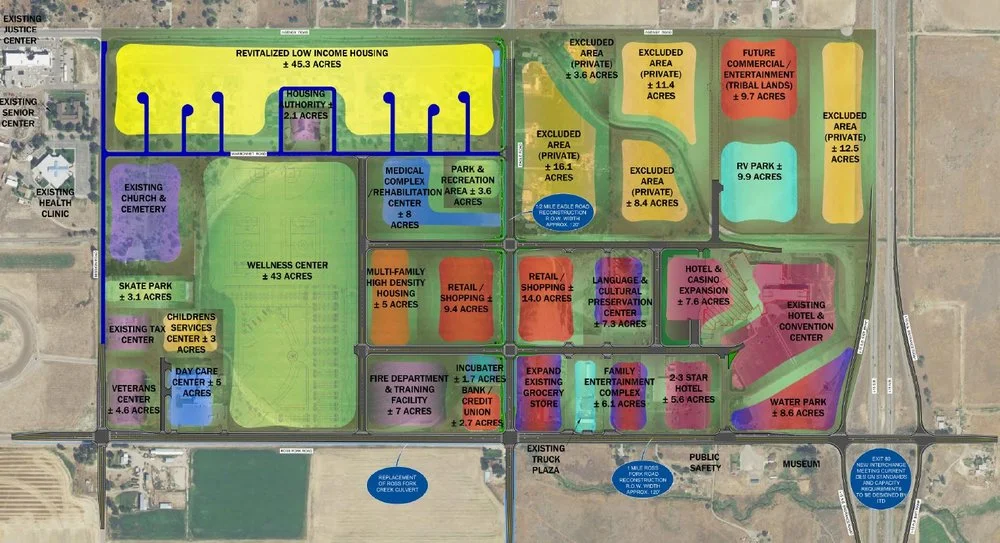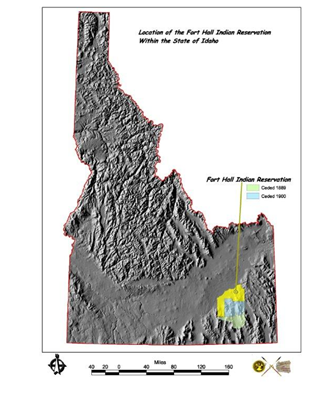Shoshone-Bannock Tribes Planning Department develops a Comprehensive Economic Development Strategy
THE SHOSHONE-BANNOCK TRIBES--EXIT 80 MASTER PLAN 2017. (SOURCE: TRIBAL PLANNING DEPARTMENT)
by Lori Edmo-Suppah
Republished courtesy of the Sho-Ban News
FORT HALL — The Shoshone-Bannock Tribes Planning Department is developing a Comprehensive Economic Development Strategy (CEDS) in part through an Economic Development Administration grant.
It is an update of the Tribes Comprehensive Plan said Sherwin Racehorse, senior planner, and much of the $95,000 grant was used to contract Agnew Beck, a company out of Boise and Anchorage, Alaska, to help create the CEDS.
Shelly Wade of Agnew Beck said since they started they’ve had a lot of conversation with tribal members, tribal leadership and have attended district meetings to ask what’s on their mind – what do they think could be done on the Fort Hall Indian Reservation to improve the quality of life?
A CEDS committee was created comprised of tribal department heads, Fort Hall Business Council members, stakeholders from surrounding communities and the planning department is leading the project.
Racehorse said the mission of the planning department is to have a comprehensive plan that includes housing, economic development, health, education, etc. He said the Tribes are driving the agenda to get comment from the outside – find a way to heal discontentment such as with the city of Pocatello.
Wade said a presentation was done before the Pocatello City Council last September where they presented about the CEDS project because it is beneficial to all. She said the Exit 80 master planning is beneficial to local communities to actively work together to do tourism – jointly market eastern Idaho. With infrastructure development, the cultural richness of the area could be shown. Many of the potential projects are conceptual but could benefit the Tribes.
There are six goals under CEDS.
Goal one is to strengthen the capacity for self determination and productive partnerships such as consider existing draft of the revised tribal organizational chart; establish an independent tribal enterprise board under a corporate charter; leverage the Tribes status and existing airport infrastructure to develop a Free Trade Zone/airfreight terminal; support tourism development and improvements along the Interstate 15 corridor.
Goal two is to promote sustainable land use planning, zoning and carefully manage natural resources. Develop and implement new planning and zoning ordinance that includes new planning and zoning commission, along with new planning and zoning department; create new reservation zoning structure and zoning map (using 2010 Comp Plan policy land level land use map as starting map); leverage Tribal water rights; develop tribal farm under corporate structure; consider spinoff opportunities.
MAP OF THE FORT HALL RESERVATION WITHIN THE STATE OF IDAHO. THE TOTAL AREA IS 546,500 ACRES. (SOURCE: SHOSHONE-BANNOCK TRIBES) ACCORDING TO THE U.S. CENSUS IN 2015, THE RESERVATION POPULATION WAS 5,896. ENROLLED TRIBAL MEMBERS IS 5,886 (67% LIVE ON THE RESERVATION), GROWTH RATE 2.3%, UNEMPLOYMENT RATE 19% (FROM THE RECENT AMERICAN COMMUNITY SURVEY—U.S. CENSUS).
Goal three is to promote healthy people and tribal wellness through continuing and supporting development of the Tribal Wellness Center; actively preserve knowledge of Bannock and Shoshone languages; create an educational program (college) for Shoshone-Bannock history, language and culture. Support youth focused cultural/wellness programs.
Goal four is to strengthen traditional and non-traditional businesses and develop a stronger workforce. Develop and implement a workforce development strategic plan based on industry. Partner with Idaho State University, Idaho National Laboratory and other regional entities to increase training and workforce development opportunities.
Goal five is to support the development, maintenance and improvement of critical infrastructure. Plan, research and secure funding to complete phase three of the gaming development at Sho-Ban including demolishing the existing casino to create space for a waterpark, two-thirds start hotel, family entertainment complex; support development of other Exit 80 programming elements including: water, sewer development and upgrades, asphalt curb and gutter development upgrades, desired/required landscaping, new RV park, cultural and language preservation center, golf course, Eagle Road Business Park; adopt and implement capital improvement plan – improve quality of life at district level through improvements and construct of new critical infrastructure; reconstruct and pave reservation roads including areas in and around the Exit 80 Master Plan areas as identified by the Tribal Improvement Program (adopted by tribal resolution.) Develop reservation-wide broadband Internet service that provides easy access to high speed Internet for personal, educational and work use.
Goal six is to ensure safe, affordable, on reservation housing options are available for all residents. Create a comprehensive tribal housing division that incorporates all income levels; develop subdivisions in accordance with smart growth; provide resources for needed renovations; develop a plant for manufactured housing.
Concerning housing, Racehorse is applying for an Administration for Native Americans grant to fund a business plan, corporate structure, development for a housing manufacturing to build homes at a reduced cost.
Last year, Planning received a $68,000 grant from the Bureau of Indian Affairs to do a feasibility study on tribal fresh pack of potatoes. It determines what the potential yield for potatoes is over a five-year period. He believes it’s feasible to build a fresh pack operation.
Racehorse said the CEDS is an overall arching document. It lays out a template for multiple projects moving forward and financing is instrumental. In the meantime they are doing master planning, code development and trying to find money through grant writing.
Wade said she would be returning to Fort Hall in April when they will again go out to reservation districts to present a draft of the final CEDS.
Lori Edmo-Suppah is the editor the Sho-Ban News – the weekly newspaper of the Shoshone-Bannock Tribes located in Fort Hall, Idaho. She has been editor for a total of 23 years. She is a graduate of the University of Montana, Missoula and has a Bachelor of Arts in Journalism. She’s served ten years on the Native American Journalists Association Board of Directors and has held the offices of president, vice president, secretary and treasurer. She also served two years on the Unity Journalists of Color Board of Directors. Edmo-Suppah worked for a year as a Journalist in Residence at the University of Idaho School of Communication (now known as School of Journalism and Mass Media) under a grant from the Freedom Forum. While there she worked on a Native journalism project titled “Idaho Natives” that upper level journalism students published. She’s also worked as a copy editor for the Idaho State Journal in Pocatello, Idaho, UCLA American Indian Studies Center publications manager and communications coordinator at The Museum at Warm Springs. During the past nine years, she has focused on learning more about her family history, culture and the Bannock language that is at risk of being lost.
Resources:
- Sho-Ban News - the weekly newspaper of the Shoshone-Bannock Tribes located in Fort Hall, Idaho
- Shoshone-Bannock Tribal website - The Shoshone-Bannock Tribes are located on the Fort Hall Reservation in Southeastern Idaho, between the cities of Pocatello, American Falls, and Blackfoot. The Reservation is divided into five districts: Fort Hall, Lincoln Creek, Ross Fork, Gibson, and Bannock Creek. Currently, 97% of the Reservation lands are owned by the Tribes and individual Indian ownership.
Republished in The Western Planner in April 2017 courtesy of Sho-Ban News


